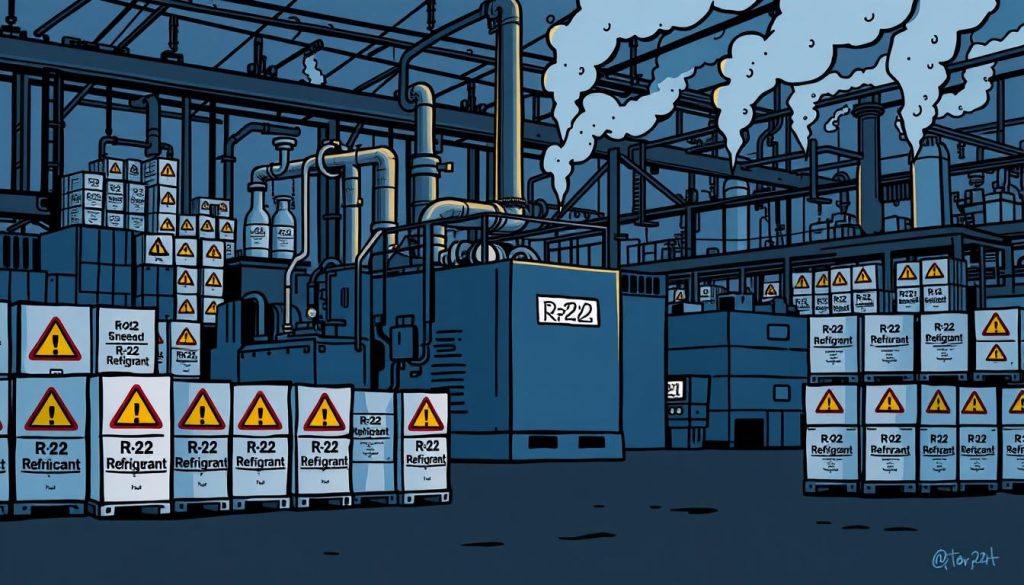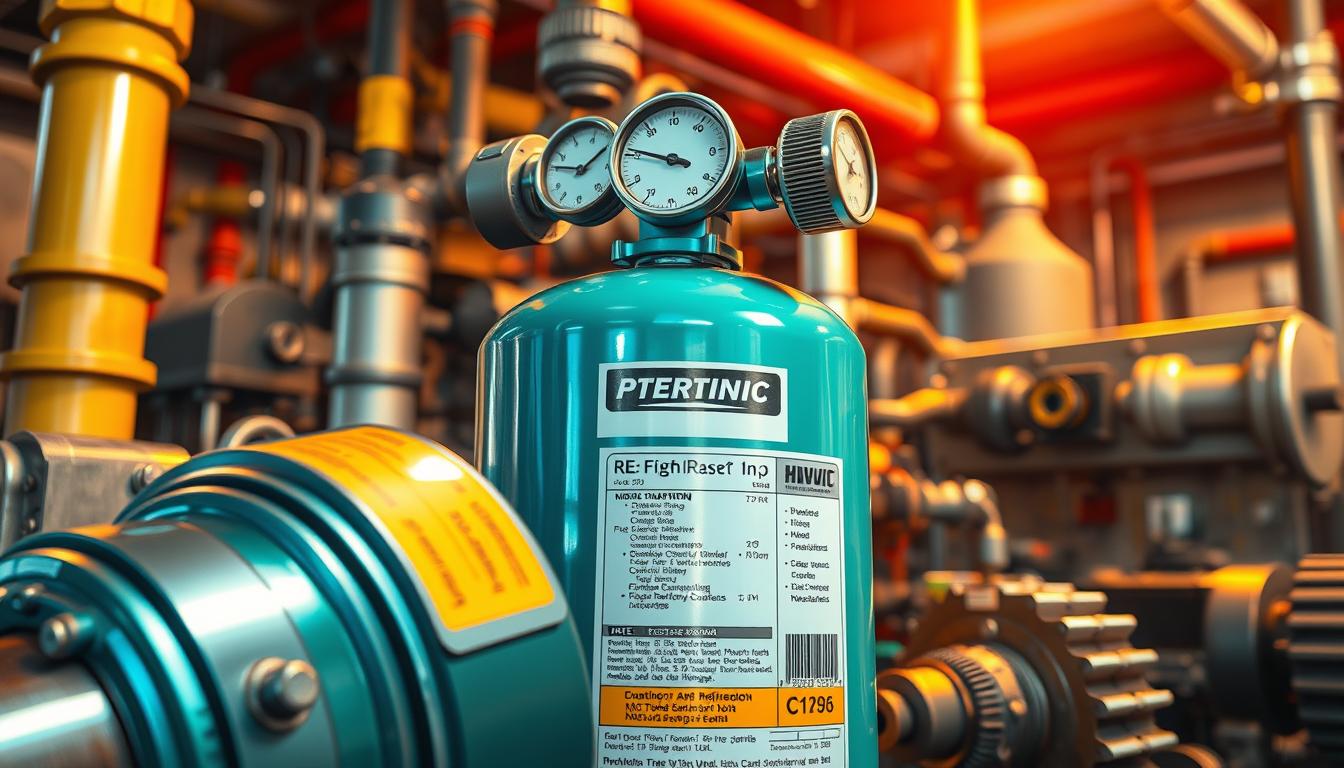If you’ve had your air conditioner recharged recently, you might have been surprised by the cost. This is especially true for those with older AC units. It’s mainly because of environmental rules.
In 2020, the Environmental Protection Agency (EPA) stopped making and importing a common refrigerant called R-22, or Freon. This move has made Freon harder to find and more expensive. As a result, HVAC companies are now charging a lot more for refrigerant refills and replacements.
Key Takeaways
- The EPA banned the production and import of the common refrigerant R-22, also known as Freon, in 2020.
- This has created a scarcity of Freon, leading to skyrocketing prices for HVAC companies and their customers.
- Older air conditioning units are heavily reliant on R-22, making them more expensive to maintain and repair.
- HVAC companies must pass on the high costs of the limited refrigerant supply to consumers.
- Investing in a newer, more energy-efficient HVAC system can help avoid these costly refrigerant issues in the long run.
The Demise of Freon and Its Impact on Costs
For years, Freon, also known as R-22, was the main refrigerant in air conditioning systems. But, research showed it harmed the environment and the ozone layer. The Montreal Protocol, signed by over 200 countries, led the U.S. EPA to ban Freon by 2020.
Freon’s Environmental Damage
Freon, a chlorofluorocarbon (CFC), damaged the ozone layer. This layer protects us from harmful UV rays. The damage increased the risk of skin cancer and eye problems worldwide.
The Montreal Protocol and EPA Phase-Out
The Montreal Protocol, signed in 1987, aimed to stop ozone-depleting substances like Freon. The EPA followed with stricter rules on Freon, banning it by 2020. This shortage has made Freon very expensive for HVAC companies and homeowners.
Dwindling Supply, Soaring Demand
The EPA’s phase-out of R-22 refrigerant, also known as Freon, has led to a big drop in its supply. Starting January 1, 2020, all domestic R-22 production stopped, and imports were banned. This has made R-22 very scarce, affecting many homeowners with aging HVAC systems that still need it.
Despite the shortage, people still want R-22 for their HVAC system age. This has caused prices to rise sharply. It’s now hard for HVAC companies to keep these older systems running.
Stringent EPA Regulations Limit Production
The EPA’s phase-out of R-22 is to protect the environment. It aims to reduce ozone-depleting substances. By January 2020, all R-22 production and imports were banned.
Aging HVAC Systems Reliant on R-22
Most HVAC systems before 2010 used R-22. As these systems get older, the need for R-22 grows. But with less supply, fixing these systems costs more for homeowners.
| Year | R-22 Production Limit | HVAC System Age | Refrigerant Supply and Demand |
|---|---|---|---|
| 2010 | 100% of 1989 baseline | New HVAC systems introduced with alternative refrigerants | Supply and demand in balance |
| 2015 | 90% of 1989 baseline | Increasing number of older HVAC systems still using R-22 | Supply starts to dwindle, demand remains high |
| 2020 | 0% of 1989 baseline (complete ban on production and imports) | Majority of HVAC systems still using R-22 | Supply severely limited, demand remains high, prices skyrocket |

Why do HVAC companies charge so much for refrigerant?
Have you noticed how much more HVAC companies charge for refrigerant now? You’re not the only one. The cost of refrigerant has gone up a lot. This is because HVAC pricing and refrigerant costs have increased a lot. This is due to factors driving high prices.
The Environmental Protection Agency (EPA) has banned some refrigerants like Freon. This means HVAC companies can’t get these important supplies easily. With high demand and less supply, they have to charge more for refrigerant refills or new systems.
Now, let’s explore why HVAC companies charge so much for refrigerant:
- Phasing out of Freon: The EPA has banned Freon (R-22) because it’s bad for the environment. This has made it hard to get, raising costs for HVAC companies.
- Stringent EPA Regulations: The EPA’s strict rules on refrigerant production and import have cut down supplies. This leaves HVAC providers with few affordable options.
- Aging HVAC Systems: Many old homes and buildings still use R-22-based systems. As supplies run low, replacing these systems becomes very expensive.
In short, HVAC companies have to raise prices for refrigerant. This is because of the EPA’s ban on Freon, strict regulations, and the need to replace old systems. These factors make it hard for them to keep costs low.
Refrigerant Price Trends
The cost of refrigerants, like R-22 or Freon, has gone up a lot lately. This is a big problem for homeowners with older HVAC systems. What used to be cheap, R-22 now costs over a few hundred dollars per pound.
Skyrocketing Costs per Pound
The price jump is because of less supply and more demand for R-22. The Environmental Protection Agency (EPA) is phasing out its use. With the ban coming, R-22 is getting harder to find. This means HVAC service providers have to charge more for simple services.
Experts say the R-22 price increase is because of the refrigerant costs per pound going up. This price trend is hard on homeowners with older systems that need Freon.
| Year | R-22 Price per Pound |
|---|---|
| 2015 | $20 |
| 2020 | $300 |
| 2023 | $500 |

Is My Old AC Unit Illegal?
If you own an older AC unit that uses R-22 refrigerant, you might wonder if it’s illegal now. The good news is, it’s not illegal to use it. But, there are important things to know about R-22 and its future impact on your HVAC system.
What’s the Deal with R-22?
R-22 refrigerant is being phased out in the U.S. because it harms the environment. It contains CFCs that damage the ozone layer. The Montreal Protocol banned its production and import. But, using what’s already available is still okay.
Can I Still Use My Existing R-22 AC Unit?
Yes, you can still use your R-22 AC unit. The ban only applies to new R-22, not what you already have. But, finding and affording R-22 to recharge it might get harder as your system gets older.
What Are My Options Moving Forward?
Using your older R-22 AC unit isn’t illegal, but the refrigerant’s cost and availability will likely rise. When it’s time to replace it, you’ll need a newer model that uses R-410A. This might be expensive, but it’s necessary to follow regulations and protect the environment.
| Refrigerant Type | Environmental Impact | Availability | Cost |
|---|---|---|---|
| R-22 (Freon) | High ozone depletion potential | Decreasing supply, phased out | Increasing significantly |
| R-410A | Low ozone depletion potential | Widely available | Relatively stable |
In summary, while your R-22 AC unit isn’t illegal, its future cost and availability might make it hard to keep using. Knowing the regulations and planning for a greener replacement can save you money in the long run.
Avoiding Costly Refrigerant Issues
Upgrading your heating and cooling system is the best way to avoid high R-22 or Freon costs. You can now install systems that use R-410A refrigerant, which is better for the environment. Although the initial cost is high, it saves money in the long run by avoiding expensive Freon refills and system replacements.
Regular HVAC system maintenance and quick leak repairs are also crucial. Catching and fixing leaks early can prevent frequent refills. This approach helps your system last longer and saves you from refrigerant shortages and price increases.
Knowing about the R-22 phaseout and the shift to R-410A helps you make smart choices. With proper care and attention, you can avoid the costly problems many homeowners face.





0 Comments